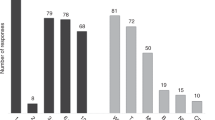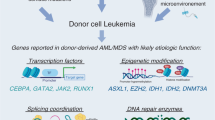Abstract
Analysis of chimerism by polymerase chain reaction amplification of STR or VNTR has become a routine procedure for the evaluation of engraftment after allogeneic stem cell transplantation. Knowledge of the frequency of different STR or VNTR alleles in unrelated individuals in a population is useful for forensic work. In the context of HLA identical sibling bone marrow transplantation the informativeness of these markers needs to be evaluated. We evaluated five STRs (THO1, VWA, FES, ACTBP2, and F13A1) and 1 VNTR (APOB) for informativeness in stem cell transplants from HLA identical sibling donors. All four markers used individually allowed us to discriminate 20–56% of the patient donor pairs. Using a combination of all these markers along with a polymorphic marker in the β-globin gene and the sex chromosome specific amelogenin marker, we were able to discriminate 99% of the patient donor pairs. We have established an algorithm for evaluating chimerism following HLA identical sibling donor transplants in the Indian population using molecular markers in 310 patients. Analysis of heterozygote frequencies in different populations is similar suggesting that this algorithm can be used universally for transplant centers to evaluate chimerism following allogeneic bone marrow transplantation.
This is a preview of subscription content, access via your institution
Access options
Subscribe to this journal
Receive 12 print issues and online access
$259.00 per year
only $21.58 per issue
Buy this article
- Purchase on Springer Link
- Instant access to full article PDF
Prices may be subject to local taxes which are calculated during checkout

Similar content being viewed by others
References
Hammond HA, Jin L, Zhong Y, Caskey CT, Chakraborty R . Evaluation of 13 short tandem repeat loci for use in personal identification applications. Am J Hum Genet 1994; 55: 175–189.
Rowold DJ, Herrera RJ . Inferring recent human phylogenies using forensic STR technology. Forensic Sci Int 2003; 133: 260–265.
Bryant E, Martin PJ . Documentation of engraftment and characterization of chimerism following hematopoietic cell transplantation. In: Thomas ED, Blume KG, Forman SJ (eds). Hematopoietic Cell Transplantation. Blackwell Science: Oxford, London, 1999, pp 197–206.
Polymeropoulos MH, Rath DS, Xiao H, Merril CR . Tetranucleotide repeat polymorphism at the human c-fes/fps proto-oncogene (FES). Nucleic Acids Res 1991; 19: 4018.
Kimpton CP, Gill P, Walton A, Urquhart A, Millican ES, Adams M . Automated DNA profiling employing multiplex amplification of short tandem repeat loci. PCR Meth Appl 1993; 3: 13–22.
Polymeropoulos MH, Rath DS, Xiao H, Merril CR . Tetranucleotide repeat polymorphism at the human beta-actin related pseudogene H-beta-Ac-psi-2 (ACTBP2). Nucleic Acids Res 1992; 20: 1432.
Peake IR, Bowen D, Bignell P, Liddell MB, Sadler JE, Standen G et al. Family studies and prenatal diagnosis in severe von Willebrand disease by polymerase chain reaction amplification of a variable number tandem repeat region of the von Willebrand factor gene. Blood 1990; 76: 555–561.
Ghanem N, Girodon E, Vidaud M, Martin J, Fanen P, Plassa F et al. A comprehensive scanning method for rapid detection of beta-globin gene mutations and polymorphisms. Hum Mutat 1992; 1: 229–239.
Schichman SA, Suess P, Vertino AM, Gray PS . Comparison of short tandem repeat and variable number tandem repeat genetic markers for quantitative determination of allogeneic bone marrow transplant engraftment. Bone Marrow Transplant 2002; 29: 243–248.
Ginsburg D, Antin JH, Smith BR, Orkin SH, Rappeport JM . Origin of cell populations after bone marrow transplantation. Analysis using DNA sequence polymorphisms. J Clin Invest 1985; 75: 596–603.
Knowlton RG, Brown VA, Braman JC, Barker D, Schumm JW, Murray C et al. Use of highly polymorphic DNA probes for genotypic analysis following bone marrow transplantation. Blood 1986; 68: 378–385.
Thein SL, Jeffreys AJ, Blacklock HA . Identification of post-transplant cell population by DNA fingerprint analysis. Lancet 1986; 2: 37.
Lawler M, Humphries P, McCann SR . Evaluation of mixed chimerism by in vitro amplification of dinucleotide repeat sequences using the polymerase chain reaction. Blood 1991; 77: 2504–2514.
Ugozzoli L, Yam P, Petz LD, Ferrara GB, Champlin RE, Forman SJ et al. Amplification by the polymerase chain reaction of hypervariable regions of the human genome for evaluation of chimerism after bone marrow transplantation. Blood 1991; 77: 1607–1615.
van Leeuwen JE, van Tol MJ, Bodzinga BG, Wijnen JT, van der Keur M, Joosten AM et al. Detection of mixed chimaerism in flow-sorted cell subpopulations by PCR-amplified VNTR markers after allogeneic bone marrow transplantation. Br J Haematol 1991; 79: 218–225.
Spyridonidis A, Zeiser R, Wasch R, Bertz H, Finke J . Capillary electrophoresis for chimerism monitoring by PCR amplification of microsatellite markers after allogeneic hematopoietic cell transplantation. Clin Transplant 2005; 19: 350–356.
Suraksha A, Khan F, Sudha T, Sonia N . Short tandem repeat technology has diverse applications: Individual identification, Phylogenetic reconstruction and chimerism based post haematopoietic stem cell transplantation graft monitoring. Indian J Med Sci 2004; 58: 297–303.
Thiede C, Bornhauser M, Ehninger G . Evaluation of STR informativity for chimerism testing – comparative analysis of 27 STR systems in 203 matched related donor recipient pairs. Leukemia 2004; 18: 248–254.
Grubic Z, Stingl K, Cecuk-Jelicic E, Zunec R, Serventi Seiwerth R, Labar B et al. Evaluation of mixed chimerism in bone marrow transplantation program in Croatia. Transplant Proc 2005; 37: 1388–1391.
Brinkmann B, Klintschar M, Neuhuber F, Huhne J, Rolf B . Mutation rate in human microsatellites: influence of the structure and length of the tandem repeat. Am J Hum Genet 1998; 62: 1408–1415.
Pugatsch T, Oppenheim A, Slavin S . Improved single-step PCR assay for sex identification post-allogeneic sex-mismatched BMT. Bone Marrow Transplant 1996; 17: 273–275.
Buno I, Nava P, Simon A, Gonzalez-Rivera M, Jimenez JL, Balsalobre P et al. A comparison of fluorescent in situ hybridization and multiplex short tandem repeat polymerase chain reaction for quantifying chimerism after stem cell transplantation. Haematologica 2005; 90: 1373–1379.
Alizadeh M, Bernard M, Danic B, Dauriac C, Birebent B, Lapart C et al. Quantitative assessment of hematopoietic chimerism after bone marrow transplantation by real-time quantitative polymerase chain reaction. Blood 2002; 99: 4618–4625.
Bader P, Niethammer D, Willasch A, Kreyenberg H, Klingebiel T . How and when should we monitor chimerism after allogeneic stem cell transplantation? Bone Marrow Transplant 2005; 35: 107–119.
Fundia AF, De Brasi C, Larripa I . Feasibility of a cost-effective approach to evaluate short tandem repeat markers suitable for chimerism follow-up. Mol Diagn 2004; 8: 87–91.
Acknowledgements
This study was supported in part by Grant BT/PRO 948/Med/13/034/98 from the Department of Biotechnology, Ministry of Science and Technology, Government of India.
Author information
Authors and Affiliations
Corresponding author
Rights and permissions
About this article
Cite this article
Sellathamby, S., Balasubramanian, P., Sivalingam, S. et al. Developing an algorithm of informative markers for evaluation of chimerism after allogeneic bone marrow transplantation. Bone Marrow Transplant 37, 751–755 (2006). https://doi.org/10.1038/sj.bmt.1705317
Received:
Revised:
Accepted:
Published:
Issue Date:
DOI: https://doi.org/10.1038/sj.bmt.1705317
Keywords
This article is cited by
-
Long-term outcome of mixed chimerism after stem cell transplantation for thalassemia major conditioned with busulfan and cyclophosphamide
Bone Marrow Transplantation (2018)
-
Population pharmacokinetics of fludarabine in patients with aplastic anemia and Fanconi anemia undergoing allogeneic hematopoietic stem cell transplantation
Bone Marrow Transplantation (2017)
-
Stem cell transplantation in India
Bone Marrow Transplantation (2008)
-
Chimerism monitoring following allogeneic hematopoietic stem cell transplantation
Bone Marrow Transplantation (2007)
-
Chimerism and tetragametic chimerism in humans: implications in autoimmunity, allorecognition and tolerance
Immunologic Research (2007)



